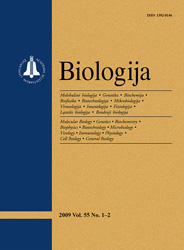Biologija / Biology
 ISSN 1392-0146 ISSN 2029-0578 (online) |
2007 m. Nr. 1 Immunohistochemical studies on distribution of ERα
in the uterus of sows with reproductive disturbances
The aim of the present study was to examine the distribution of oestrogen receptor alpha (ERα) in the uterus of sows with reproductive disturbances as well as to study the expression of ERα in relation to plasma oestradiol-17β (E2) and progesterone (P4) concentrations in the blood. Crossbred 3–4 parity Lithuanian White x Danish Landrace breed sows presenting various reproductive disturbances were recruited for the present study. Immunohistochemical investigation of sows’ uterus horns was carried out by the streptavidin–biotino peroxidase method using antibodies against ERα. Blood samples were collected from the jugular vein 1 h prior to slaughter for analysis of E2 and P4 levels.
Examination revealed that ovaries in 78.3% of sows remained active during the supposed anoestrus. 5% of the sows with active ovaries, as it became evident after post-mortem examination, were in oestrus despite the fact that no visual signs of oestrus were observed before slaughtering. The ERα were distributed in all uterine tissue compartments: surface epithelium, subepithelial connective tissue, glandular epithelium and in muscle cells of the myometrium. The lowest number (<30%) and lowest staining intensity (+) of positively stained for ERα nuclei found in uterine wall compartments were observed at oestrus, though the E2 concentration in blood was high (43.03 pmol/l). Glandular epithelial nuclei stained positively for ERα in >80% of cells at late dioestrus, but staining intensity differed through the rest of the oestrus cycle stages. The most prominent staining of ERα in the myometrial cells was found at pro-oestrus when E2 was high (350.79 pmol/l) and P4 was low (15.45 nmol/l), and at late dioestrus when the concentration of E2 and P4 was low (3.42 and 0.19 nmol/l, respectively). The concentration of P4 was high (49.01 nmol/l) at dioestrus and low at late dioestrus, while the concentration of E2 was low at both stages. The intensity of nuclear positive staining varied not only among the stages of the oestrus cycle, but also among the different uterine compartments. In conclusion, we determined that sows with reproductive disturbances had cyclic active ovaries, but the levels of P4 and E2 in their plasma did not fully fit the physiological norm of these hormones during their oestrus cycle. Similarly, ERα expression in different uterine compartments of sows is the very low. Keywords: reproductive disturbances, oestrus cycle, ovaries, hormone receptors, sow |
Issues:
2011 - Vol.57 No. 1, No. 2, No. 3 2010 - Vol.56 No. 1-4 2009 - Vol.55 No. 1-2, No. 3-4 2008 - Vol.54 No. 1, No. 2, No. 3, No. 4 2007 - Vol.53 No. 1, No. 2, No. 3, No. 4 2006 No. 1, No. 2, No. 3, No. 4 2005 No. 1, No. 2, No. 3, No. 4 2004 No. 1, No. 2, No. 3, No. 4 2003 No. 1, No. 2, No. 3, No. 4 2002 No. 1, No. 2, No. 3, No. 4 2001 No. 1, No. 2, No. 3, No. 4 |